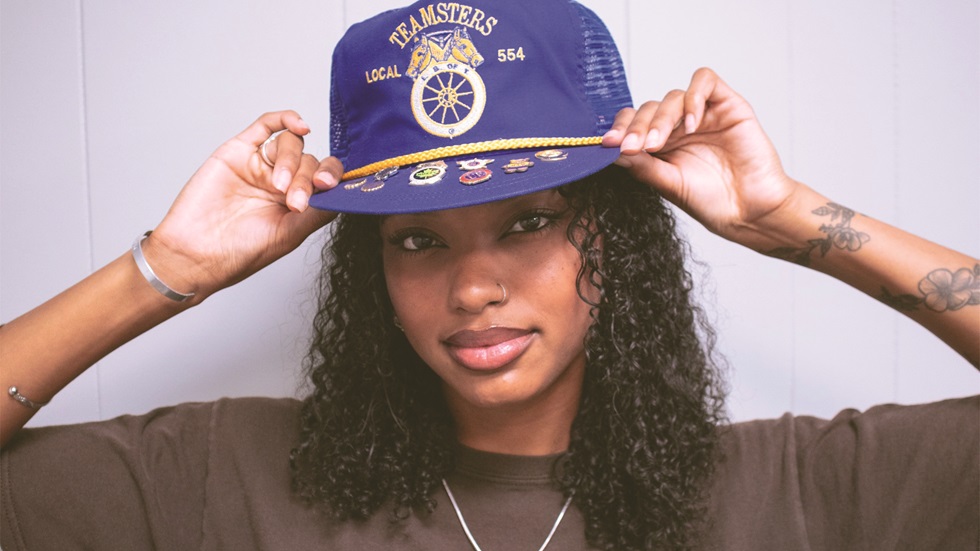
An earlier version of this article originally appeared in Sartorial, a student-run magazine for all things fashion, beauty, and culture, published at the Missouri State University. Photos are by Braeden Cooper. Models: Billie Collins, Chris Pajda, Chloe Holt, and Bryesen Cooper.
The first thing most people think about when they hear the word “fashion” isn’t labor unions. Likewise, when people hear about labor unions, they normally don’t think about fashion. Yet, the two are inextricably connected via one key link: working-class people.
I recently interviewed Justine Medina, a Cuban-American woman, activist, and rank-and-file organizer for the Amazon Labor Union at the JFK8 Amazon Fulfillment Center in Staten Island, N.Y. She helped clarify what unions do and why they’re important.
“A labor union is a simply an organization of workers,” Medina said. “Tey’re formed in and across workplaces by workers to advocate for their rights, such as proper treatment and fair wages, but they can and often do fight for wider and more expansive fair treatment for workers.” 
So how do labor unions tie into the fashion industry?
Organizing is in
As it turns out, some of the oldest and most powerful workers’ organizations in U.S. history have been textile and garment unions, from the International Ladies Garment Workers Union (ILGWU) to the Textile Workers Union of America (TWUA) and many more.
These organizations, often representing mostly women and immigrants, have been responsible for factory legislation, safety laws, fair labor practice laws, and labor laws for women and children—and they did it all through the power of strikes and organizing.
Though these exact unions no longer exist under those names, today’s garment and fashion workers are represented in a range of unions, such as Workers United, Unite Here, the Retail, Wholesale, and Department Store Union (RWDSU), and others.
“When most successful, labor unions are often militant and rank-and-file led,” according to Medina. “They support other workers across unions and work together in alliance to struggle to change other political issues as well.”
“Labor unions,” she said, “are key to ultimately changing society because they struggle against oppression at the sight of capitalist production”—the economic force which drives our society.
“Unions and unionists have always played an indisputable role in civil rights, human rights, and socialist revolutionary politics everywhere you find these struggles globally,” Medina argued.
Next season’s solidarity
Labor unions are, of course, still in fashion, and it’s looking like they’re going to be in next season as well.
When turning on the news or checking social media, it’s hard not to notice the increase of striking workers all around the country. Whether it’s SAG-AFTRA and the Writers Guild of America, Starbucks Workers United, the 340,000-strong UPS Teamsters doing practice pickets, or the 140,000 United Auto Workers hitting the picket line, it’s all of organized labor that is utilizing fashion to advance their goals.
When looking at these striking workers, you’ll see that matching shirts, jackets, hats, and pins promoting their organization are front and center, and that’s on purpose.
“Often, union shirts and buttons are worn strategically during a specific campaign, such as when they are building towards a strike,” explained Medina. “Workers and organizers will coordinate all of the union members in the workplace to wear the same shirt in solidarity on a certain day, to both signal a threat to the company [to try to force demands] and show each other that the union support is strong.”
Unions on trend
Union wear has even spiked in trendiness, as Gen-Z is more pro-union than any other generation, with unions having an average approval rating of 64.3%, compared to millennials at 60.5%, Gen-X at 57.8%, and 57.2% for Baby Boomers.
The prevalence of union clothing in recent trends has grown. As designer wear becomes increasingly unaffordable, unions and union-made clothing are catching people’s eyes. It certainly isn’t rare to see someone online or in person rocking a union hat or bomber jacket.
Pair a vintage AFL-CIO SAG-AFTRA shirt and cargo pants, maybe throw a Teamsters hat in there as well. Or, rock a United Auto-Workers jacket with one of the seemingly endless assortment of union enamel pins! Not into streetwear? Try checking out the vintage ILGWU dresses and jackets online to see if they fit your style.
Though a large number of clothing brands have moved production overseas—killing jobs, breaking up unions, and exploiting cheap, unprotected labor—there are still several ways you can support unions and union-made clothing.
Some union-made clothing brands include: Justice Clothing, Demoulin Apparel, Kenneth Gordon, Leather Coats, Sterling Wear, Union Shirts Supply, Ethix Supply, and even a portion of Carhartt’s workers is organized under the UFCW union, among other unionized fashion and apparel brands.
So go out and rep your fellow workers and do it with style!
We hope you appreciated this article. At People’s World, we believe news and information should be free and accessible to all, but we need your help. Our journalism is free of corporate influence and paywalls because we are totally reader-supported. Only you, our readers and supporters, make this possible. If you enjoy reading People’s World and the stories we bring you, please support our work by donating or becoming a monthly sustainer today. Thank you!












Comments